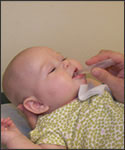Fogarty scientists model path of rotavirus outbreaks
July - August, 2009 | Volume 8, Issue 4

Photo courtesy CDC
Widespread use of
rotavirus vaccine has
dramatically reduced
emergency room visits.
New vaccines have the potential to prevent or temper epidemics of the childhood diarrhea-causing disease rotavirus, protect the unvaccinated and raise the age at which the infection first appears in children, Fogarty and other federal researchers reported recently.
The findings were based on changing patterns of rotavirus transmission in the United States, where the disease is rarely fatal, and they have implications for combating epidemics in other countries where the death toll is much higher.
The research, published in the journal Science, is based on mathematical modeling that takes into account regional birth rates and predicted vaccination levels and effectiveness. The model suggests that when 80 percent or more of children in a given population are vaccinated, annual epidemics may occur on a less regular basis and more unvaccinated children will be protected.
Data from 2007 and 2008, when vaccination first reached appreciable coverage levels in the United States, validate the model's predictions.
The study showed for the first time that the timing of rotavirus epidemics is dependent on the birth rate in the population because they are driven by infants who have never been infected before. In the United States, winter outbreaks would typically occur sooner in the higher birth rate states of the Southwest and later in the Northeast, where birth rates tend to be lower.
But with the introduction of two vaccines, the first in 2006, rotavirus outbreaks may become less frequent and less pronounced. They also may make their first appearance in children when they are older than the previous norm of less than 5 years of age, according to the research.
In older children, later onset would likely mean fewer cases and less severity of diarrhea.
The modeling and analysis were done by a team of researchers from Fogarty the Centers of Disease Control and Prevention, the Agency for Healthcare Research and Quality, the Pennsylvania State University, Princeton University and the George Washington University.
"When you can observe the immediate effects of vaccination and compare them to what the model predicted, you have a head start on stopping this preventable disease in countries where rotavirus unnecessarily kills hundreds of thousands of children," said Fogarty Director Dr. Roger I. Glass, one of the study authors.
"Rotavirus vaccines have rapidly and dramatically reduced hospitalizations and emergency room visits for gastroenteritis in American children," said investigator Dr. Umesh D. Parashar, of CDC's Center for Immunization and Respiratory Diseases. "This research not only explains the effects of the U.S. rotavirus vaccination program, but also lays the foundation for understanding the tremendous life-saving benefits of vaccination in the developing world, where more than half a million children die from rotavirus each year."
Lead author Dr. Virginia Pitzer, of Penn State and Fogarty said, "Each population is going to have a different demographic makeup, and there may be conditions we cannot predict with certainty, but we believe introducing vaccination in the developing world will decrease the terrible burden of rotavirus."
More Information
Virginia E. Pitzer, Cécile Viboud, Lone Simonsen, Claudia Steiner, Catherine A. Panozzo, Wladimir J. Alonso, Mark A. Miller, Roger I. Glass, John W. Glasser, Umesh D. Parashar and Bryan T. Grenfell. "Demographic Variability, Vaccination, and the Spatiotemporal Dynamics of Rotavirus Epidemics." Science 17 July 2009: 290-294.
To view Adobe PDF files,
download current, free accessible plug-ins from Adobe's website.